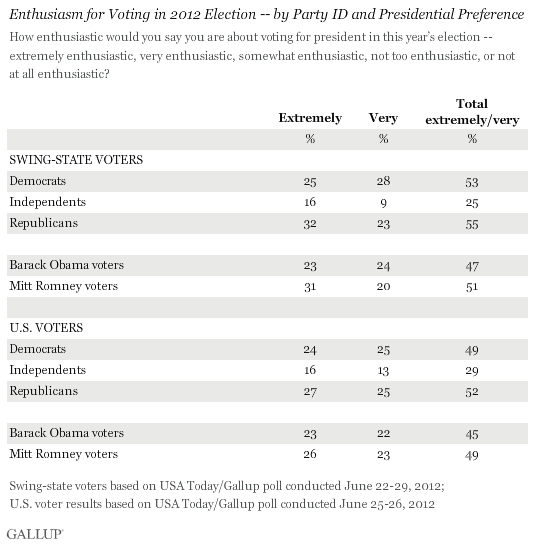PRINCETON, NJ -- Voters in this year's key election battleground states are similar to registered voters nationally in the enthusiasm they express about voting in the 2012 presidential election. Just under half of swing-state voters, 46%, as well as 43% of national voters, report feeling extremely or very enthusiastic about voting.

The new results are from the USA Today/Gallup Swing States poll, conducted June 22-29 as part of Gallup Daily tracking with 1,200 registered voters in 12 states where the presidential race is expected to be closely contested: Colorado, Florida, Iowa, Michigan, Nevada, New Hampshire, New Mexico, North Carolina, Ohio, Pennsylvania, Virginia, and Wisconsin.
Enthusiasm among all U.S. voters was 48% last October and rose to 52% in January as the Republican primaries kicked off, but then dropped to 42% in March. It has since remained at about this level. Swing-state voters' enthusiasm has been flat at 46% to 48% since last fall, except for the same temporary uptick in January.
The resulting three- to four-percentage-point gap between U.S. and swing-state voters' enthusiasm since March is not large, but may in fact be real, given the consistency with which it has appeared in the last three surveys.
Specifically, about a quarter of voters in swing states and nationally are extremely enthusiastic about voting this year, and another 21% of each are very enthusiastic. One-quarter say they are somewhat enthusiastic, while roughly 30% are either not too or not at all enthusiastic.

Romney Voters Lead in Feeling "Extremely Enthusiastic" in Swing States
The June swing-states poll showed 47% of registered voters across the 12 swing states backing President Barack Obama for president and 45% backing the presumptive Republican nominee, Mitt Romney.
However, voters in swing states who support Romney for president are more likely than those backing Obama to say they feel "extremely enthusiastic" about voting -- 31% to 23%. The same pattern is seen by party, with 32% of Republicans in the swing states and 25% of Democrats reporting extreme enthusiasm. However, these candidate- and party-level differences disappear when one looks at total enthusiasm, defined as those either extremely or very enthusiastic.
The findings contrast with the May USA Today/Gallup Swing States poll, in which supporters of Obama and Romney expressed equal levels of extreme enthusiasm, while Obama led Romney in their respective supporters' overall enthusiasm.
Nationally, Romney and Obama voters report similar levels of both extreme and overall enthusiasm, as do national Republicans and Democrats. Thus, to the extent extreme enthusiasm proves to be a benefit to Romney in terms of voter turnout this fall, it is currently a factor only in the swing states, not nationally.

Bottom Line
Swing-state voters differ little from voters nationally in the overall enthusiasm they feel about voting in this year's presidential election. However, Romney's supporters in the swing states are more likely than Obama's to be extremely enthusiastic, something that could give Romney a slight electoral dividend in voter turnout in these states if it continues. However, so far this metric has shown poll-to-poll variation, and thus it bears watching.
More broadly, the similarity between swing-state voters' and U.S. voters' overall enthusiasm contrasts with a 20-percentage-point difference in the two groups' exposure to presidential TV advertising. More than four in five swing-state voters, 82%, report they have already seen a presidential campaign ad on TV, compared with 62% of voters in non-swing states. Thus, the campaign ads running to date have not dampened swing-state voters' enthusiasm, which is at least on par with, if not a bit higher than, that of voters nationwide.
Survey Methods
Results for voters in this USA Today/Gallup 2012 Election swing states survey are based on telephone interviews conducted June 22-29, 2012, on the Gallup Daily tracking survey, with a random sample of 1,200 registered voters, aged 18 and older, living in Colorado, Florida, Iowa, Michigan, Nevada, New Hampshire, New Mexico, North Carolina, Ohio, Pennsylvania, Virginia, and Wisconsin. The data represent a subset of Gallup's national daily tracking survey for those dates. The swing-state data are weighted to be demographically representative of the combined population in those 12 states.
For results based on the total sample of swing-state registered voters, one can say with 95% confidence that the maximum margin of sampling error is ±4 percentage points.
For results based on the total sample of 577 registered voters in non-swing states, one can say with 95% confidence that the maximum margin of sampling error is ±5 percentage points. Interviews with non-swing-state voters were conducted as part of Gallup Daily tracking June 25-26.
Interviews are conducted with respondents on landline telephones and cellular phones, with interviews conducted in Spanish for respondents who are primarily Spanish-speaking. Each sample includes a minimum quota of 400 cell phone respondents and 600 landline respondents per 1,000 national adults, with additional minimum quotas among landline respondents by region. Landline telephone numbers are chosen at random among listed telephone numbers. Cell phone numbers are selected using random-digit-dial methods. Landline respondents are chosen at random within each household on the basis of which member had the most recent birthday.
Samples are weighted by gender, age, race, Hispanic ethnicity, education, region, adults in the household, and phone status (cell phone only/landline only/both, cell phone mostly, and having an unlisted landline number). Demographic weighting targets are based on the March 2011 Current Population Survey figures for the aged 18 and older non-institutionalized population living in U.S. telephone households. All reported margins of sampling error include the computed design effects for weighting and sample design.
In addition to sampling error, question wording and practical difficulties in conducting surveys can introduce error or bias into the findings of public opinion polls.
View methodology, full question results, and trend data.
For more details on Gallup's polling methodology, visit www.gallup.com.
